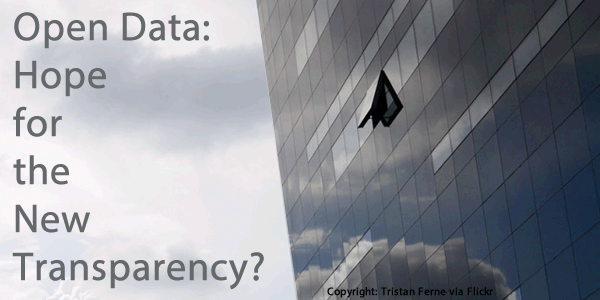Our comprehensive report on surveillance in Canada is available. Download it here.
Open Data: Hope for the New Transparency?
- January 30, 2015

The Government of Canada and the United States Government are actively promoting the open data movement. Both governments have websites that offer information on current projects and provide resources for cities wishing to develop open data policies and practices. Both countries identify approximately 50 cities that have open data programs in place. The United States government frames open data as an opportunity to make government more accountable and transparent while increasing citizenship participation. The Government of Canada paints a similar picture, suggesting open data fosters public access to, and participation in, government policy and practice. Both governments make use of the term ‘transparency’ in describing the benefits of the open data movement.
At the local level, municipal government officials ultimately choose what types of data will be open. The open data policy for The City of Toronto, to take one example, suggests the municipality will “…share with everyone its open and accessible datasets while adhering to rights of privacy, security and confidentiality…” [i]The City of Chicago published an Open Data Executive Order in 2012 that says the municipality “…is committed to creating an unprecedented level of transparency, honesty and accountability to the public…”[ii] The executive order includes a provision for ‘protected data’ (which is defined by privacy legislation) as well as data on salaries and expenses. It goes on to include provisions for “…any data, which, if disclosed on the City of Chicago data portal, would raise privacy, confidentiality or security concerns or jeopardize or have the potential to jeopardize public health, safety or welfare” (ibid). For a variety of reasons some data clearly should be ‘protected’, which raises questions around how different data sets are categorized as ‘open’ or ‘closed’.
The open data movement is relatively new and is still evolving. The City of Philadelphia has gained recognition as a leader in the development of policy and practice, and has recently released a new strategic plan. The plan addresses the issue of how data sets are chosen for publication and identifies considerations such as privacy concerns, demand and cost of publishing.[iii] Interestingly, the difficulty of getting certain data sets published led to the resignation of Mark Headd who had served as the Chief Technology Officer for the city. In a recent interview he claims there was resistance to releasing data related to ‘salaries and spending’, the kind of data he believes is a measure of true transparency.[iv]
This points to the need for local citizens to advocate for open data. Civic hacking groups have formed in many cities to collaborate on ways to use data sets and push for increased transparency of local government. The Open Data Philly group, which was started by Headd, “…seeks to improve access to data about Philadelphia, increase government transparency and accountability, drive and encourage innovative uses of the data, and inform citizens about our region’s trends”.[v] The Open Edmonton collective in the City of Edmonton brings public sector employees, data analysts and citizens together to develop open data projects and promotes ‘hackathons’. Members of the open data community in Edmonton are organizing a local event as part of the International Open Data Hackathon taking place in February. Several other cities in Canada and the United States are also organizing events.
The open data movement is an interesting and exciting development in surveillance studies. The increasing transparency of citizens as a result of state and corporate practices has dominated both academic research and mainstream media. However, surveillance is not inherently oppressive, discriminatory or dominating; it is ambiguous. [vi]In this time of mass surveillance critical inquiry must undoubtedly continue and expand. However, there is an equally important opportunity for surveillance studies to call attention to the benefits that can accrue from increased transparency of the state.
[i]City of Toronto, “Open Data Policy.”
[ii]City of Chicago, “Open Data Executive Order (No. 2012-2).”
[iii]City of Philadelphia, Open Data Strategic Plan.
[iv]Zaleski, “Welcome to the Open Data Movement’s Turbulent Teenage Years.”
[v]Open Data Philly, “Open Data Philly - About.”
[vi]Lyon, The Electronic Eye: The Rise of Surveillance Society; Bennett et al., Transparent Lives: Surveillance in Canada.
References:
Bennett, Colin J, Kevin Haggerty, David Lyon, and Valerie Steeves. Transparent Lives: Surveillance in Canada. Edmonton, Canada: Athabasca University, 2014.
City of Chicago. “Open Data Executive Order (No. 2012-2).” http://www.cityofchicago.org/city/en/narr/foia/open_data_executiveorder.....
City of Philadelphia. Open Data Strategic Plan. Philadelphia: City of Philadelphia, October 2014.
City of Toronto. “Open Data Policy,” 2012. http://www1.toronto.ca/wps/portal/contentonly?vgnextoid=7e27e03bb8d1e310....
Lyon, David. The Electronic Eye: The Rise of Surveillance Society. Minneapolis: Polity Press, 1994.
Open Data Philly. “Open Data Philly - About.” http://opendataphilly.org/about/.
Zaleski, Andrew. “Welcome to the Open Data Movement’s Turbulent Teenage Years,” January 12, 2015. http://nextcity.org/features/view/open-data-cities-mark-headd-philadelph....





